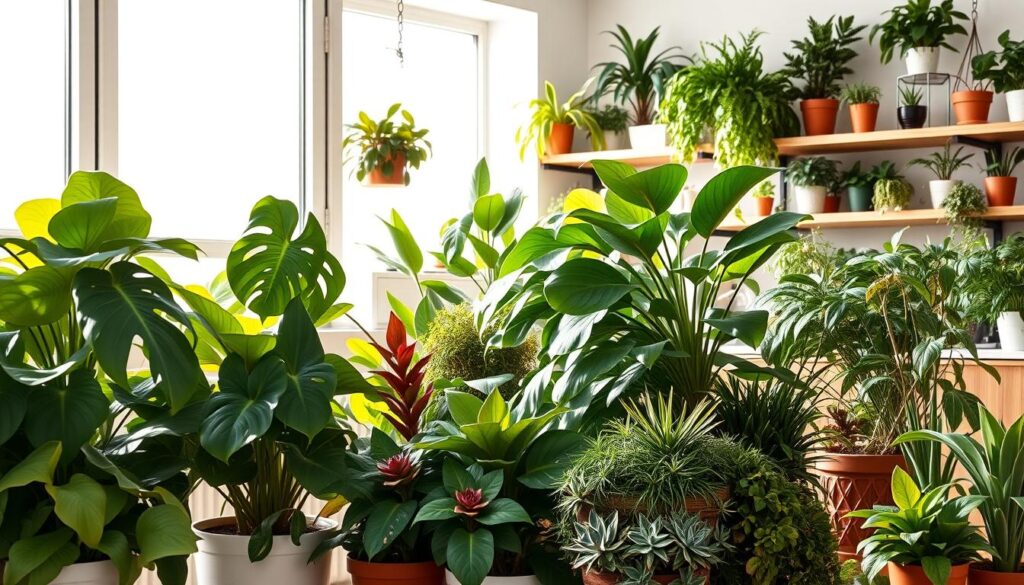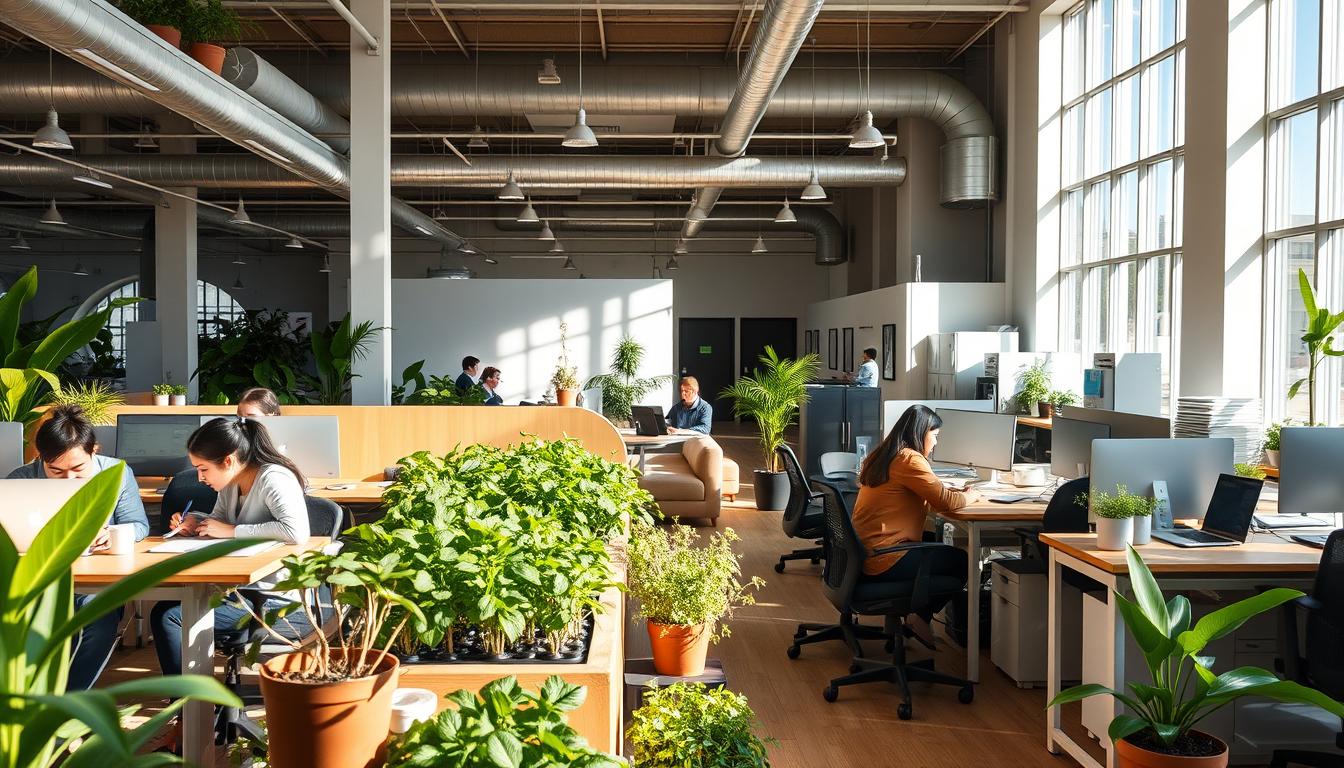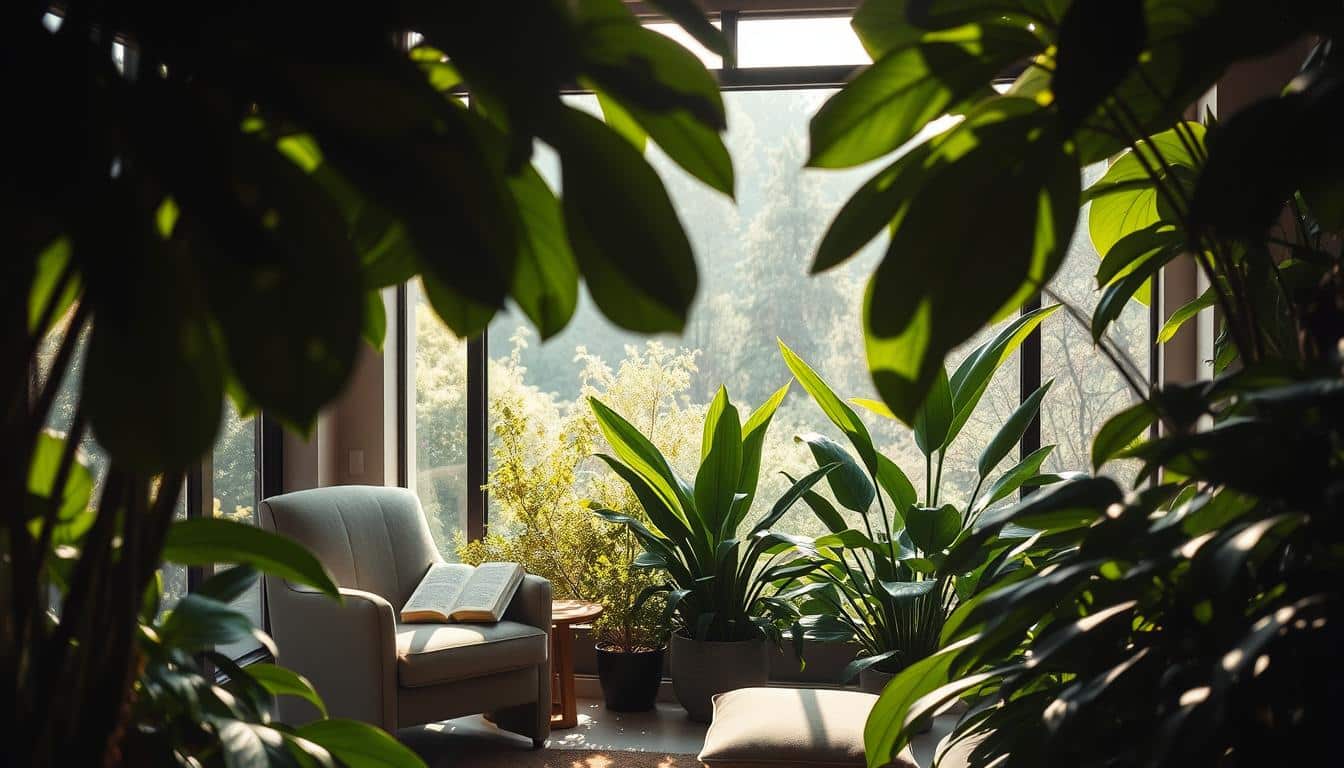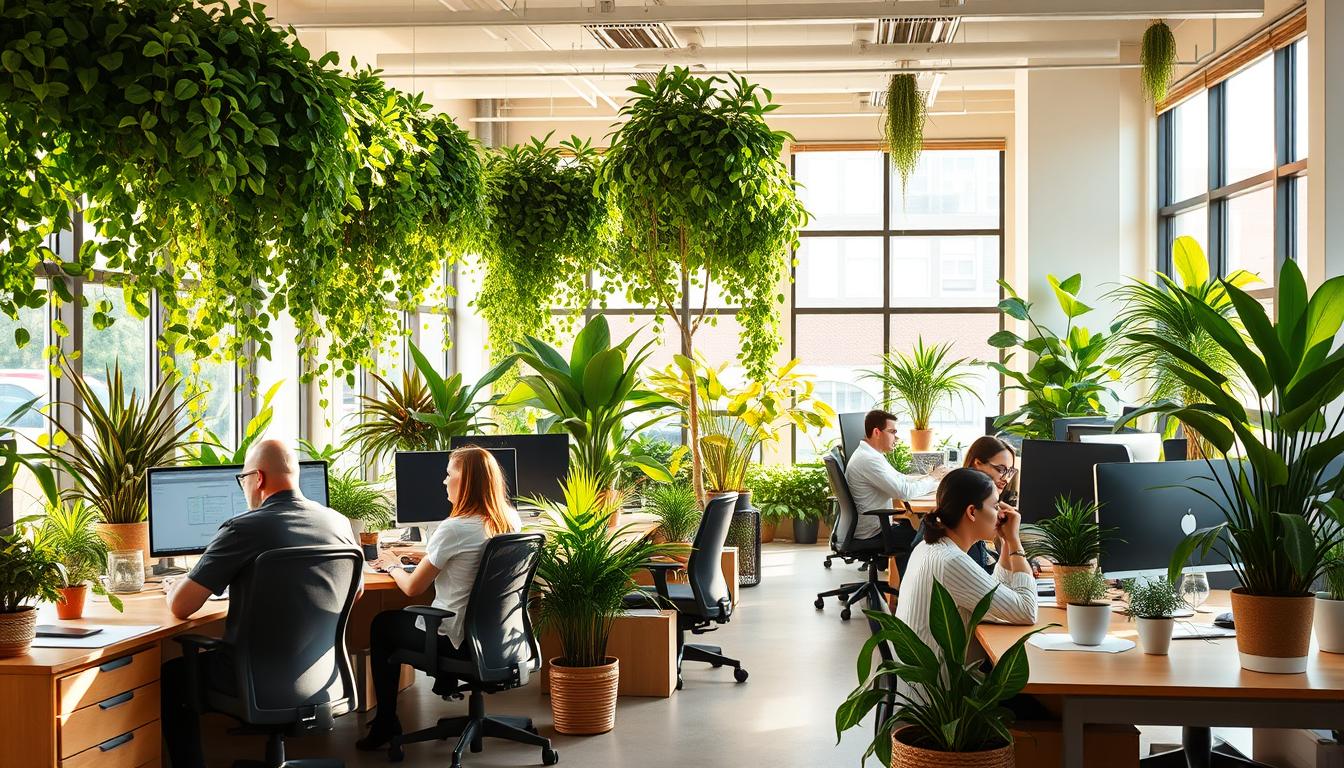Adding different plants to office spaces has many benefits. It makes the air better and the workplace more beautiful. Having plants indoors is great for health and makes work feel less stressful. Bringing nature inside helps workers feel good, which is really important now.
Diverse plants in the office can make it more comfortable and help people work better. This article talks about how having various plants can improve the air and make employees happier. When the work environment is healthier, everyone does a better job.
Understanding Workplace Plant Diversity
Workplace plant diversity means having many kinds of plants in office spaces. It helps people feel more connected to nature. By adding different plants, offices look better and workers feel happier and healthier.
Studies show plants can make the air cleaner, cut down on stress, and make people more satisfied with their jobs. When offices have lots of plants, they become more welcoming and exciting. This makes employees work better and stay more involved.
Adding various plants to the office helps create a pleasant environment. Each type of plant offers something special, like cleaning the air or keeping moisture levels right. Putting money into plant diversity shows a company cares about connecting with nature.

Importance of Microclimates in the Workplace
Microclimates play a big role in how comfortable a workplace feels. These small climate zones can be different throughout an office, affecting how well employees work and feel. Adding plants is a smart move to control these conditions, because they can adjust temperature and moisture. This makes the office a nicer place to work, which can lead to better job performance.
Modern offices with lots of glass can have issues like changing temperatures, drafts, and too much heat. Plants help by soaking up sunlight and putting moisture into the air. This cools the place down. So, workers don’t get distracted by being too hot or too cold, and they can do their jobs better.
Using plants in the office does more than just make it look good. It also makes the air cleaner and the climate more comfortable, which can spark creativity and teamwork. So, by adding greenery thoughtfully, workplaces can improve how they deal with climate issues and make a better working environment.
Enhancing Air Quality Through Plant Diversity
Adding indoor plants to workspaces can greatly improve air quality. These plants act as natural air cleaners, removing harmful substances. They create a healthy atmosphere for employees. Better air quality means healthier and more productive employees. Workplaces with lots of plants see fewer people calling in sick.
Impact on Employee Health and Well-being
Indoor plants do more than look good. They help lower stress in the workplace. This makes for a happier work environment and could lead to higher job satisfaction. The cleaner air from plants also helps employees think clearly and concentrate better. This is a good reason to fill the office with a variety of plants.
Coping with “Sick Building Syndrome”
“Sick Building Syndrome” (SBS) happens when bad air quality affects building occupants. It can cause headaches, tiredness, and breathing issues. This is often due to poor ventilation and pollutants. Using indoor plants is a smart way to fight SBS. They clean the air, reducing SBS symptoms for workers. Adding plants and smart design can decrease SBS problems, showing it’s important to keep indoor spaces healthy.
Boosting Workplace Productivity with Plants
Adding plants to workspaces brings many benefits, like better productivity and more creativity amongst employees. These greens make the place look good and help in coming up with new ideas. By having plants around, companies can make everyone work better together.
Plants and Creativity Enhancement
Studies show that having plants around can make employees more creative. Being in a place filled with plants helps people think of new ideas easily. Plants help by:
- Increasing focus and concentration
- Improving mood and motivation
- Boosting inspiration and imagination
This makes workers feel more into their jobs and full of energy in a green workspace. Adding different plants can turn any work area into a creative hotspot.
Reduction of Absenteeism
Using plants in the office also means less time off work for employees. Research links green spaces with less stress and happier work life. Plants help by:
- Making the air cleaner for better health
- Creating a relaxing environment to reduce stress
- Making employees generally happier
Choosing a variety of plants leads to a healthier office environment. This means employees are less likely to call in sick. All of this matters a lot for keeping work going without any stops.
Workplace Plant Diversity and Microclimate
Adding plants to the workplace does more than just make it look good. They also help create natural microclimates. These special environments boost the air quality and comfort. This makes the office a better place to work and helps employees feel good and do their best.
How Plants Create Natural Microclimates
Plants play a big part in making these microclimates by controlling humidity and heat. They release moisture, making the air feel better. This also keeps indoor temperatures steady, making offices nicer places to be in. By putting plants in certain spots, we can make their cooling effects even stronger.
Energy Conservation in Office Spaces
Using plants indoors can also cut down on how much energy we use. They cool down spaces and keep them warm, so we don’t have to use heaters or AC as much. This saves money and is good for the planet. Workplaces that use plants well can really save a lot on energy. This shows how important plants are in modern office design.
The Aesthetic Value of Plants in the Workplace
Adding plants to the office makes it look and feel better. This not only makes the space nicer but also helps employees feel good. Plants do more than just decorate; they make people happier at work.
Studies show that offices with plants are more appealing to job seekers and boost staff happiness. Plants create a welcoming space, attracting new and current employees. Offices with beautiful plant displays keep their staff longer and see better work performance.
To get the most from plants, businesses should pick types that match their office’s style. The right plants make boring offices bright and lively. This improves the looks and the mood, leading to better teamwork and creativity.
Reducing Noise Levels with Greenery
In today’s busy work life, finding workplace tranquility is tough, mainly in open offices where sound spreads easily. Adding plants helps a lot in noise reduction. They act like a natural sound block, soaking up sound waves and cutting down noise pollution.
Many studies show the good plants impact on how an office sounds. Using different plants makes the office look better and feel calmer. Placing greenery smartly can lower distracting noises. This makes it easier for employees to focus and be more productive.
Smartly adding plants to office designs makes a big difference in controlling sound. This step not only makes employees happier and more comfortable. It also boosts how much work they get done. Putting nature in the workplace helps balance being productive and enjoying nature’s calm.
Guiding Space Design with Plant Arrangements
Placing plants smartly is key in modern workspace design. They can mark different areas, making the office look organized. This helps everyone find their way around easily.
Adding plants to offices does more than one thing. They can act like natural walls, giving privacy but keeping things open. Plus, plants make a place more welcoming, which can boost how happy and productive people are at work.
Different plants serve different purposes in a workspace. Big plants might stand between common spaces, and small ones can make desks feel personal. By carefully choosing plants, designers can make the office both good-looking and better to work in.
Types of Plants to Incorporate in Workplace Design
Adding the right indoor plants can make your workplace look better and the air healthier. Different kinds of indoor plants not only make the place more attractive. They also help keep employees healthy by cleaning the air. It’s important to pick plants that clean the air well to make a healthier working space.
Best Indoor Plants for Air Quality
There are many indoor plants known for cleaning the air. When picking the best ones, think about these points:
- Peace Lily: Does well in dim light and gets rid of harmful substances like ammonia and formaldehyde.
- Snake Plant: Very tough, it changes CO2 to oxygen overnight, which is great for air quality.
- Spider Plant: Adapts easily, great at removing pollutants, and simple to look after.
Adaptable Plants for Various Workplace Environments
Selecting adaptable indoor plants helps them fit into different office designs. Some of the top choices for workplaces are:
- ZZ Plant: Can survive with little light and doesn’t need much water.
- Pothos: Does well under various conditions, making it perfect for different settings.
- Dracaena: Comes in many types, each fitting different light and humidity levels.
Implementing Greenery: Tips and Best Practices
Adding plants to the workplace needs careful planning. This ensures they make a positive impact. A well-planned interior landscape can make your work area look better and feel more inviting.
Creating a Successful Interior Landscaping Plan
Here are some steps to draft an effective plan:
- Assess the space: Look for spots where plants will do well and help workers focus.
- Determine the purpose: Figure out if you want plants for their looks, to clean the air, or to boost mood.
- Plan for maintenance: Pick a care plan that keeps your plants healthy.
Choosing the Right Plants for Your Space
Choosing plants wisely is super important. Think about these factors:
- Light levels: Know how much natural light your workspace gets to pick suitable plants.
- Moisture requirements: Go for plants that match the watering and humidity conditions.
- Aesthetic fit: Make sure the plants fit the overall style and feel of the space.
Measuring the Impact of Workplace Plants
We look at how workplace plants affect employees’ happiness and work rate by reviewing many studies. These studies show big benefits, both in numbers and personal stories. They help businesses see how adding plants can make a big difference.
Research-Focused Case Studies
Many studies give strong proof of workplace plants’ advantages. Highlights include:
- Improved Employee Satisfaction: A study by the University of Exeter found plants in offices made workers 15% happier.
- Enhanced Productivity Levels: Harvard University’s research linked more greenery with a 6% rise in worker productivity.
- Reduced Stress Levels: The Journal of Environmental Psychology’s study showed plants cut stress by 30%, boosting spirits at work.
- Health Benefits: The Human Environment Research Lab noted a 20% drop in employee sickness in plant-filled workplaces, suggesting they’re healthier places.
By looking into these case studies, companies can wisely choose to add plants. They learn about the real gains for a better, more efficient work space.
Conclusion
Adding many kinds of plants to work areas brings big benefits. These aren’t just nice to look at. They make the air cleaner. This helps employees stay healthy and work better.
Plants do more than just look good. They create little natural zones that save energy. By using different plants, companies make places where ideas grow and people feel calm.
When updating their office design, companies should really think about using more plants. This approach makes the workplace better in many ways. It helps everyone’s health and keeps them focused on their work.



